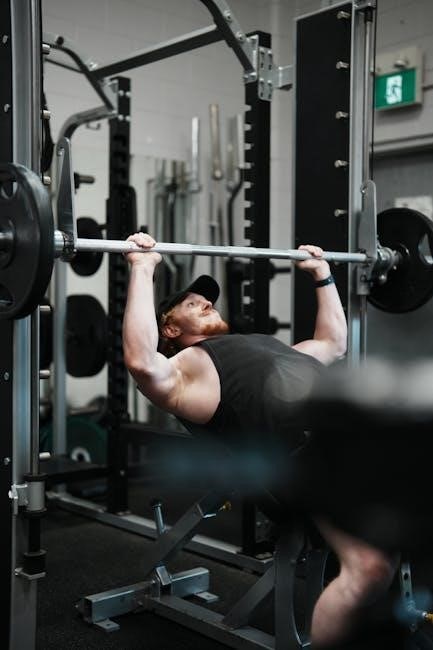A well-structured athlete workout program PDF provides detailed training plans, exercises, and nutrition advice to enhance performance. These programs are designed to improve strength, endurance, and overall fitness through organized routines.
1.1 Understanding the Importance of Structured Training
Structured training is essential for athletes seeking consistent progress and optimal performance. A well-designed athlete workout program PDF ensures workouts are organized, goal-oriented, and scientifically backed. It helps athletes avoid plateaus by incorporating periodization, where training intensity and volume are tailored to specific phases. This approach prevents overtraining and reduces injury risks. With a structured plan, athletes can track progress, stay motivated, and ensure each session contributes to their long-term goals. Additionally, structured programs often include nutrition and recovery strategies, which are critical for maximizing results. By following a detailed schedule, athletes can focus on targeted improvements, whether it’s building strength, enhancing endurance, or mastering specific skills. A structured program also fosters accountability, helping athletes stay disciplined and committed to their training journey. Ultimately, it provides a clear roadmap to success, making it indispensable for serious athletes aiming to achieve peak performance.
1.2 Benefits of Using a Workout Program PDF
A workout program PDF offers numerous benefits for athletes, providing a clear, organized, and accessible training guide. It ensures consistency and accountability, helping athletes stick to their routines. The PDF format allows for easy access on mobile devices, making it convenient to follow workouts anywhere. Detailed exercise instructions, including sets, reps, and tempo, guide athletes through each session. Many programs also include warm-up routines, nutrition advice, and recovery tips, creating a holistic approach to fitness. PDFs often feature progressive overload strategies, ensuring continuous improvement. They cater to various fitness levels, from beginners to advanced athletes, offering scalable workouts. Additionally, PDF programs are cost-effective and environmentally friendly compared to printed materials. With a structured plan in hand, athletes can track progress, stay motivated, and achieve their goals more efficiently. This makes a workout program PDF an indispensable tool for anyone serious about their training journey.

Program Duration and Structure
Athlete workout programs vary in duration, from 4-week speed-focused plans to 12-week hybrid training. Each week targets specific goals like strength, endurance, or power, with detailed workout schedules and nutrition tips.
2.1 4-Week Workout Program

A 4-week workout program is designed to enhance an athlete’s speed, strength, and power. Each week focuses on specific goals, such as improving explosiveness or building muscular endurance. The program includes Olympic lifts, plyometrics, and cardio exercises, with detailed instructions for each workout. It incorporates supersets and trisets to maximize efficiency, along with warm-ups and cool-downs. The plan also emphasizes proper nutrition and recovery techniques to support progress. Athletes can download a free PDF to access the full schedule, exercise instructions, and tips for adjusting the intensity based on their fitness level. This structured approach ensures consistent improvement over the four weeks, making it ideal for those seeking a short-term, high-impact training plan.
2.2 6-Week Strength and Endurance Plan
This 6-week strength and endurance plan is designed for athletes seeking to build both muscular strength and cardiovascular fitness. The program focuses on compound lifts like squats, bench presses, and deadlifts, combined with cardio exercises such as cycling or rowing. Each week progresses in intensity, starting with foundational strength work and gradually introducing higher loads. The plan includes detailed workout schedules, with strength sessions and endurance workouts separated for optimal results. Athletes can download a free PDF to access the full plan, which also provides guidance on nutrition, recovery, and heart rate-based training. This structured approach ensures balanced development, making it ideal for those aiming to enhance overall fitness and performance. The program is flexible, allowing athletes to adjust based on their current fitness level and goals.
2.3 12-Week Beginner Hybrid Athlete Training
The 12-week beginner hybrid athlete training program is tailored for those new to structured fitness, combining strength, plyometrics, and cardio. Each week includes specific workout sessions with detailed exercises, sets, and rep schemes. The program emphasizes progressive overload, allowing athletes to gradually increase intensity while maintaining proper form. It incorporates optional cardio sessions for added endurance. Designed to introduce athletes to various training methods, the program focuses on building a strong foundation. The structured approach ensures safety and steady progression, making it ideal for newcomers. A free PDF download is available, providing a comprehensive guide to the entire 12-week plan. This program is a great starting point for individuals aiming to improve overall fitness and prepare for more advanced training in the future. Its balanced approach ensures well-rounded development for hybrid athletes.

Types of Training

Athlete workout programs offer various training types, including strength, endurance, and hybrid training. These structured plans enhance performance through targeted exercises and periodization, ensuring balanced development for optimal results.
3.1 Strength Training

Strength training is a cornerstone of athlete workout programs, focusing on building muscular power and endurance. It typically involves compound lifts like squats, bench presses, and deadlifts, which target multiple muscle groups. These exercises are essential for enhancing athletic performance, as they improve power output and overall muscle mass. Many programs, such as the 4-week and 6-week plans, incorporate progressive overload, where weights or reps are gradually increased to challenge muscles and promote growth. For example, a 6-week strength and endurance program emphasizes heavy weights alongside cardiovascular fitness, ensuring athletes develop both muscle and stamina. Proper form and periodization are crucial to avoid injury and prevent plateaus. By structuring strength training sessions with specific rep schemes and rest periods, athletes can achieve consistent progress and peak performance. This approach ensures that strength gains are sustainable and transferable to real-world athletic demands.
3.2 Endurance Training

Endurance training is a critical component of athlete workout programs, focusing on improving cardiovascular fitness and muscular stamina. It involves activities like cardio, interval training, and long-duration exercises to enhance an athlete’s ability to sustain effort over time. Many programs, such as the 6-week strength and endurance plan, incorporate Zone 2 cardio and high-intensity interval training (HIIT) to build aerobic capacity. For example, a 6-week program combines strength exercises with cardiovascular workouts, aiming for a 50-50 split between the two. Endurance training also includes optional sessions for additional cardio, ensuring athletes can perform at peak levels during prolonged events. Proper periodization and consistency are key to avoiding burnout and maximizing results. By integrating endurance training into a structured workout plan, athletes can improve their overall performance, delay fatigue, and maintain high energy levels throughout competitions. This balanced approach ensures endurance gains are sustainable and complementary to strength development.
3.3 Hybrid Training
Hybrid training combines strength, endurance, and mobility exercises to create a well-rounded fitness program. It is designed for athletes seeking versatility and overall fitness rather than focusing on a single goal. A 6-week hybrid program, for example, integrates compound lifts, cardio, and flexibility work to enhance athleticism. This approach allows athletes to improve multiple fitness aspects simultaneously, making it ideal for those who need adaptability. Hybrid training often includes periodized plans, where exercises and intensities vary weekly to avoid plateaus. For instance, one week might focus on building strength, while another emphasizes endurance. This balanced method ensures athletes develop a broad skill set and physical resilience. By mixing different training modalities, hybrid programs cater to athletes aiming for holistic development and long-term performance improvements. They are particularly popular among those who need to maintain fitness across various disciplines or sports. This versatility makes hybrid training a cornerstone of modern athlete workout programs.
3.4 Periodization in Training
Periodization in training involves structuring workout programs into specific phases to optimize performance and prevent plateaus. This approach divides the training year into distinct periods, such as off-season, pre-season, in-season, and recovery. Each phase focuses on different goals, like building strength or enhancing endurance. For example, an annual strength training plan might start with foundational work in the off-season, progress to intensity in the pre-season, and maintain performance during the in-season. Periodization ensures athletes peak at the right time and reduces the risk of overtraining. It also allows for strategic recovery phases to promote long-term progress. By varying training intensity, volume, and exercises, periodization keeps workouts effective and engaging. This method is widely used in athlete workout programs to ensure sustained improvement and adaptability. Properly implemented, it enhances overall performance and supports athletes in achieving their goals.
Phases of Training
Training phases include off-season, pre-season, in-season, and recovery, each tailored to build strength, endurance, or maintain performance, ensuring athletes peak at the right time while reducing overtraining risks.
4.1 Annual Strength Training Plan

An annual strength training plan is structured into four phases: off-season, pre-season, in-season, and recovery. The off-season focuses on building foundational strength and power through progressive overload, while the pre-season aims to peak strength and prepare for competition. During the in-season, the focus shifts to maintaining strength and preventing overtraining. The recovery phase emphasizes active rest and mobility to rejuvenate the body. Each phase incorporates specific rep schemes, exercise selections, and periodization strategies to ensure athletes achieve peak performance at the right time. This structured approach helps athletes avoid plateaus and reduces the risk of injury, ensuring long-term progress and sustainability in their training. By following this plan, athletes can systematically improve their strength and overall performance throughout the year.
4.2 In-Season Training
In-season training focuses on maintaining strength and endurance while minimizing overtraining. The program emphasizes low-volume, high-intensity workouts to preserve peak performance during competitions. Athletes engage in sport-specific exercises that align with their competitive demands, ensuring they remain sharp and ready. Active recovery techniques, such as mobility drills and light cardio, are incorporated to aid muscle repair and prevent fatigue. The goal is to sustain the gains made in the off-season while adapting to the physical and mental stresses of competition. This phase also includes strategic deload weeks to allow the body to recover fully. By balancing maintenance and recovery, in-season training ensures athletes can perform at their best without compromising long-term progress or risking injury.
4.3 Recovery Phase
The recovery phase is a critical component of athlete workout programs, designed to allow the body to heal and adapt after intense training. This period focuses on reducing physical stress while maintaining minimal activity to promote muscle repair and mental rejuvenation. Techniques such as light cardio, stretching, and mobility exercises are commonly used to enhance blood flow and flexibility without overexertion. Active recovery methods, like swimming or cycling at low intensity, are also recommended to aid in the removal of metabolic waste products. Additionally, deload weeks are often incorporated, where training volume and intensity are significantly reduced to prevent overtraining. Proper nutrition, hydration, and sleep are emphasized to support the body’s recovery processes. The goal of this phase is to ensure athletes return to training refreshed, injury-free, and ready to perform at their best.
Nutrition and Recovery
Nutrition and recovery are vital for athletes, ensuring optimal performance and muscle repair. Proper hydration, balanced diets, and adequate sleep support physical recovery, while techniques like stretching and light cardio aid in active recovery.
5.1 Importance of Nutrition for Athletes
Nutrition plays a critical role in an athlete’s performance, recovery, and overall success. A balanced diet rich in proteins, carbohydrates, and fats provides the energy and nutrients needed for intense training. Proper hydration is equally essential to maintain physical function and endurance. Athletes must align their nutrition with training schedules to optimize energy levels and recovery. A well-structured meal plan supports muscle repair, growth, and adaptation, enabling athletes to perform at their best. Neglecting nutrition can lead to underperformance, fatigue, and increased risk of injury. Therefore, prioritizing nutrition is as important as the workout itself. Many athlete workout program PDFs include nutrition guides to help athletes fuel their bodies effectively. By focusing on quality foods and timing, athletes can enhance their training outcomes and achieve their fitness goals more efficiently. Consulting with a nutritionist can further tailor these plans to individual needs.

5.2 Recovery Techniques for Optimal Performance
Recovery is a cornerstone of any effective athlete workout program, ensuring the body heals and adapts to training demands. Adequate rest, stretching, and foam rolling help reduce muscle soreness and improve flexibility. Incorporating low-intensity activities, such as yoga or light cardio, can enhance blood flow and promote recovery. Proper hydration and sleep are also vital, as they support muscle repair and overall physiological balance. Many programs recommend active recovery techniques, such as swimming or cycling, to maintain mobility without overexertion. Additionally, rest days are essential to prevent overtraining and allow the body to rebuild. By prioritizing recovery, athletes can maintain consistent performance, reduce injury risk, and achieve long-term progress. A well-rounded approach to recovery ensures athletes are prepared for their next training session, making it a key component of any successful workout program.

Conclusion and Next Steps
Implementing a structured athlete workout program PDF ensures consistent progress and optimal performance. Download your chosen plan, stay committed, and track your journey to achieve lasting fitness success.
6.1 Final Thoughts on Athlete Workout Programs
A well-designed athlete workout program PDF is essential for achieving fitness goals, whether it’s building strength, endurance, or overall athleticism. These structured plans offer clarity and guidance, ensuring athletes stay on track. Consistency, proper nutrition, and recovery are key to maximizing results. The variety of programs available, from 4-week to 12-week plans, caters to different needs and skill levels. Hybrid training, combining strength and endurance, is particularly effective for well-rounded development. Downloading a PDF ensures accessibility and ease of use, allowing athletes to focus on execution. Remember, progress takes time and dedication. By following a structured program and maintaining discipline, athletes can unlock their full potential and achieve lasting success in their fitness journey.
